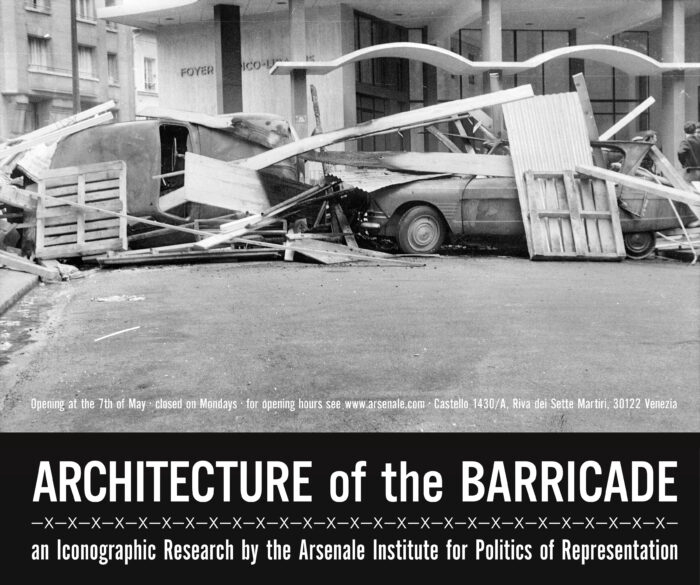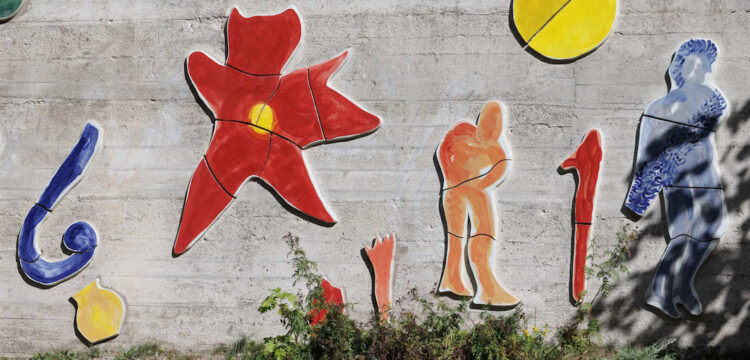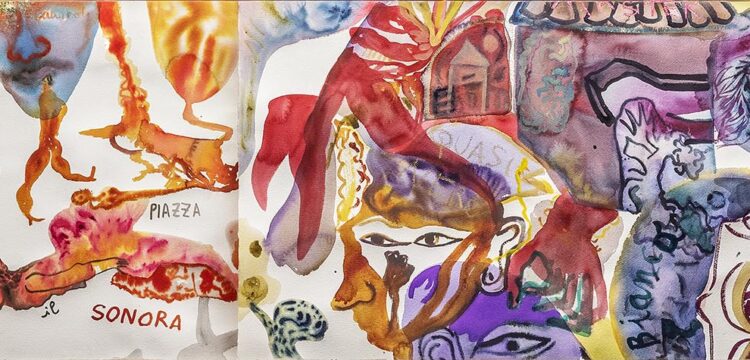Dialogues of Light
…sound, and memory: on the ever-evolving art of Alice Visentin
It all begins with the idea of a porous body—inscribed, experienced through encounters with others, and shaped by the sharing of ideas and experiences. This informs the creative process of Alice Visentin as a continuous quest and a constant desire to mix, overlap, and unlearn, in a flow that breaks temporal and cultural barriers. From this, new narratives emerge where meetings and exchanges intertwine with light, sound, and images, becoming the gateway to an infinite archive of life and memories. In this way, Visentin’s works often take the form of maps and diaries, guiding us through interior and collective territories where the artistic gesture becomes an invitation to explore the boundless potential of imagination and fantasy.
This conversation offers a glimpse into the artist’s most recent painting and performative works, showcased through the solo exhibition Everyday Mystery at Gió Marconi Gallery in Milan and her latest projects, In the Voices of Others and Sol Invictus, respectively at Kunsthalle Winterthur in Switzerland and ICA Milano.
Barbara Niniano: Over the past year, you have experienced a period rich in travel, encounters, and movement. How have these experiences influenced your work? Do you feel they have brought about an evolution in your artistic practice?
Alice Visentin: Meeting people and immersing myself in new communities has allowed me to know myself more deeply. I’ve encountered different perspectives and blended with them. I’ve discovered many new books and visited numerous artists’ studios.
I believe every human being is a storyteller. Recently, I’ve exchanged countless stories, uncovering sides of myself and my work that I didn’t know, and I feel invisible threads connecting me to people and places far away. My way of interpreting the world constantly evolves, and my work does the same. For example, I am beginning a project for the Walk&Talk Art Biennial on the Azores Islands, titled Gestures of Abundance, for which I will collaborate with cloistered nuns. I am deeply interested in visible and invisible places in the world.
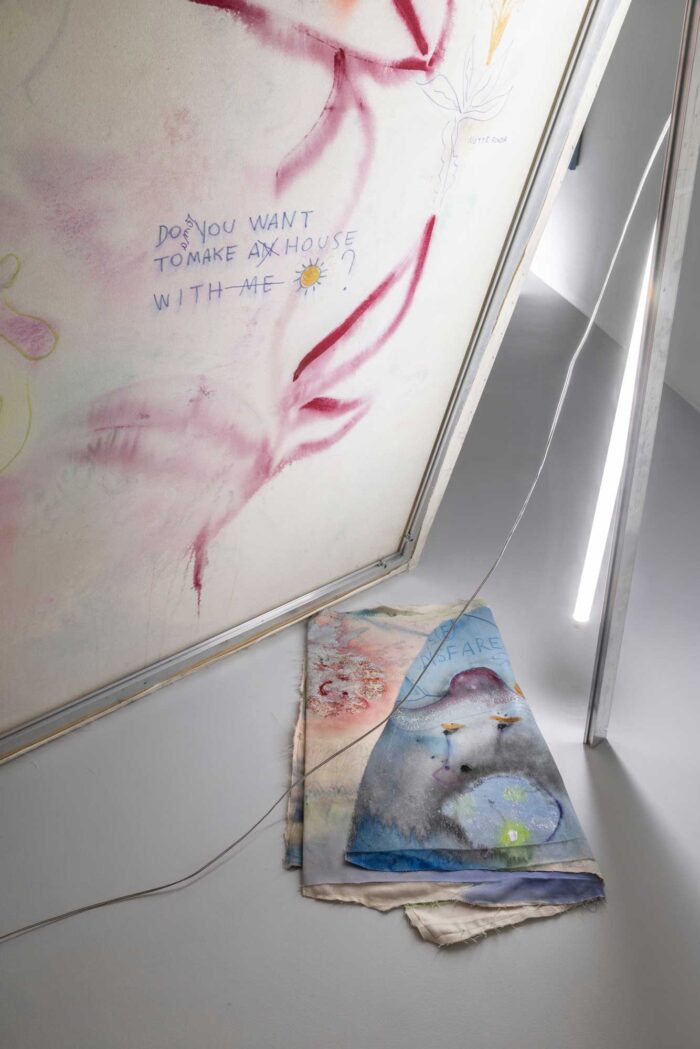
Your most recent works, presented in the solo exhibition Everyday Mystery, which recently concluded at Gió Marconi, can be considered true visual diaries. While visiting the exhibition, I felt immersed in a universe of porous bodies, archiving within themselves encounters, shared ideas, and experiences. I’d like to ask: what role has, and continues to have, the theme of the archive in your work?
The human body, the body of a place, and even objects are layers of memories and stories, for me. Seeing the world through this lens is endlessly powerful. With every encounter—with a person, a story, or a place—this power is revitalized. Recognizing ourselves as living archives leads us to exchange opinions, believe in the power of words, and keep ourselves alive. We are part of an immense community of storytellers, and I enjoy reminding myself of this through my works.
Understanding what kind of storyteller to be, and what to remain porous to, is daily work. To do so, I use the tools I know, and often I seek new ones: I read, learn cooking recipes, take notes, mix photographs, written and spoken phrases, sounds, fairy tales, words, and images.
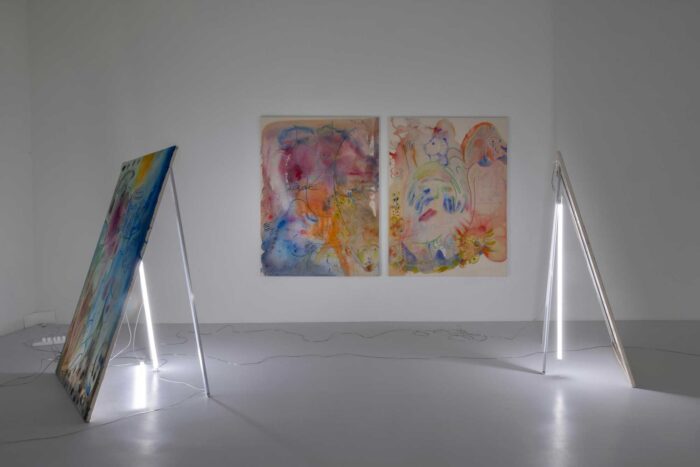
In your creative approach, you emphasize a particular, almost childlike technique: “unlearning.” How do you translate this concept into your works?
In my opinion, unlearning means staying close to the child actor within me, perceiving clues and paths with wonder. It involves trying to interpret the world differently from how I was “taught.“
My research approach involves understanding that I am not alone and that my works allow me to expose myself with devotion to bodies and lives that existed before me. Creating visual collages helps me collect, comment on, and emphasize thoughts, ideas, or stories.
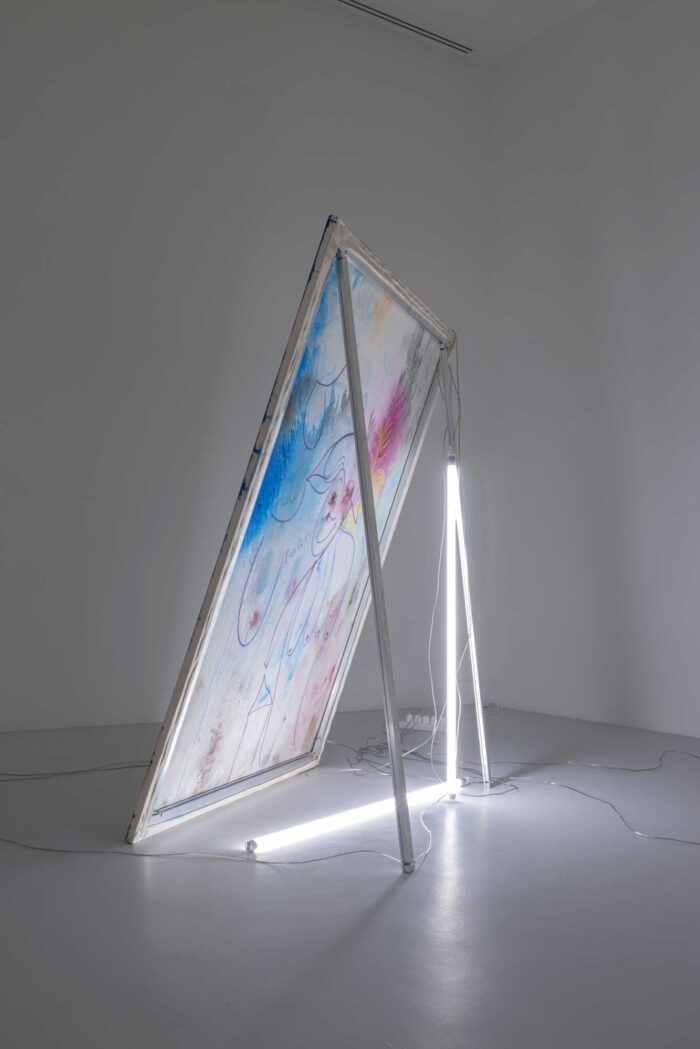
I’d like to explore the role of light in your works. In Everyday Mystery, light not only plays a central function, comparable to the other techniques you use, but also helps shape the exhibition display. Can you tell me more about this aspect?
For me, light is the consequence of a diary in the world and allows us to see inner and outer stories, both personal and cultural. Alongside light, shadows, semi-light, twilight, and darkness also play fundamental roles.
I like to think that my works can exist in many states of light, without becoming less or more legible because of it. I’m discovering the exhibition display as a space of possibilities I didn’t know before and enjoy experimenting with it. I am fascinated by ritual bonfires, the light of a scanner, flashlights creating shadows, and computer keyboards. I hope to work with these elements soon!
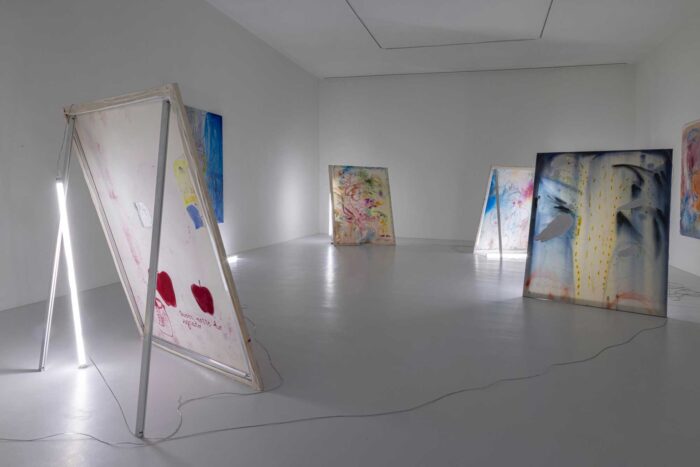
Let’s talk about your latest performance, Material for a Thousand Stories, presented at Kunsthalle Winterthur in Switzerland as part of the program In the Voices of Others curated by Marta Federici, and at ICA Milan during the Sol Invictus project curated by Gioia Dal Molin. I’d like to analyze this work from three main perspectives: light, sound, and image. Starting with the first aspect and linking back to the previous question, light seems to be the thread connecting your recent pictorial works to this narrative, which focuses primarily on the pre-cinema world and moving images.
How did the idea for this performance arise? How did it develop?
I began experimenting with an overhead projector a few years ago, which I found at a friend’s house, and I fell in love with it. I enjoy the dysfunctionality of old computers, phones, projectors, and how they communicate through electricity, countless chaotic cables, Bluetooth, hotspots, hard drives, and more cables.
This led me to ask whether using different technologies could help me tell stories from multiple temporal and spatial perspectives. What might happen if I combined moving images from a magic lantern with shadow puppets, marionettes, and digital images on a Macbook?
The performances Material for a Thousand Stories, presented at ICA Milan and Kunsthalle Winterthur, feature different reels and sounds, but both gather material for hundreds of stories. I paint and write signs, words, and dialogues on thin, long sheets of transparent plastic, attaching wooden sticks at their ends to manually scroll and roll the story on the overhead projector’s mirror. When I turn on the power, the episcope lights up, and I feel its potential to teach me new things.
The anagogic films I create incorporate fragments of works. I enjoy cutting and tracing over film reels, splicing them together with tape, and doing the reverse. For instance, I’ve transcribed a piece from Marguerite Duras’s My Places, which begins in one film and ends in another.
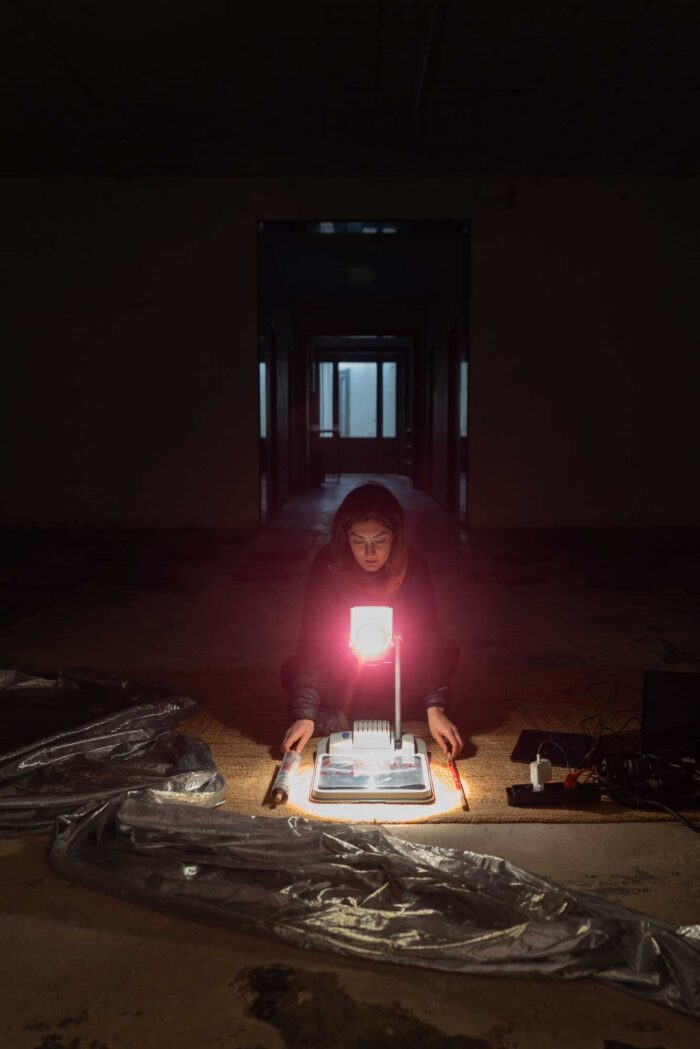
Sound plays a profound role intertwined with the visual experience of this work. What role and value do you attribute to sound? Do you think it can also function as a tool for archiving—or unarchiving—fragments, ideas, and different temporalities?
Absolutely. I think sound is a wonderful tool capable of archiving moments and stories. For example, for Material for a Thousand Stories, presented at Kunsthalle Winterthur, I used a small environmental recorder throughout the summer. I recorded the wind in Sardinian caves, my father recounting the story of an inn that no longer exists, an elderly gardener speaking about her first nursery called Desert, and fragments from Silvia Federici’s Wages Against Housework campaign found at London’s MayDay Rooms.
With these recordings, I collaborated with Mattia Splendore, who mixed and edited the material. Collaborating with others from different disciplines always adds a new layer of overlap.
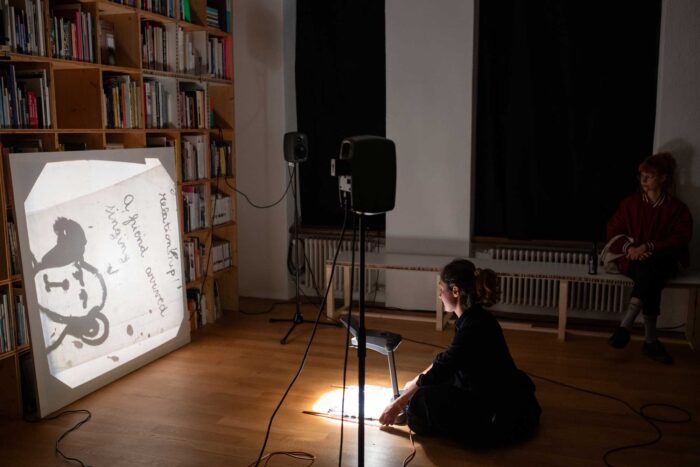
Winterthur. Photo Roman Surber. Courtesy the artist and Kunsthalle Winterthur.
What role does the image play in this narrative space?
Increasingly in my work, images come from multiple sources, which is why I often trace shapes and words on transparent sheets.
The image is my primary medium, acting as a glue between words and sounds. I’m interested in all kinds of images—painted, printed, drawn, projected, hidden, fragmented, misunderstood, or requiring interpretation. I believe in their narrative and healing power.
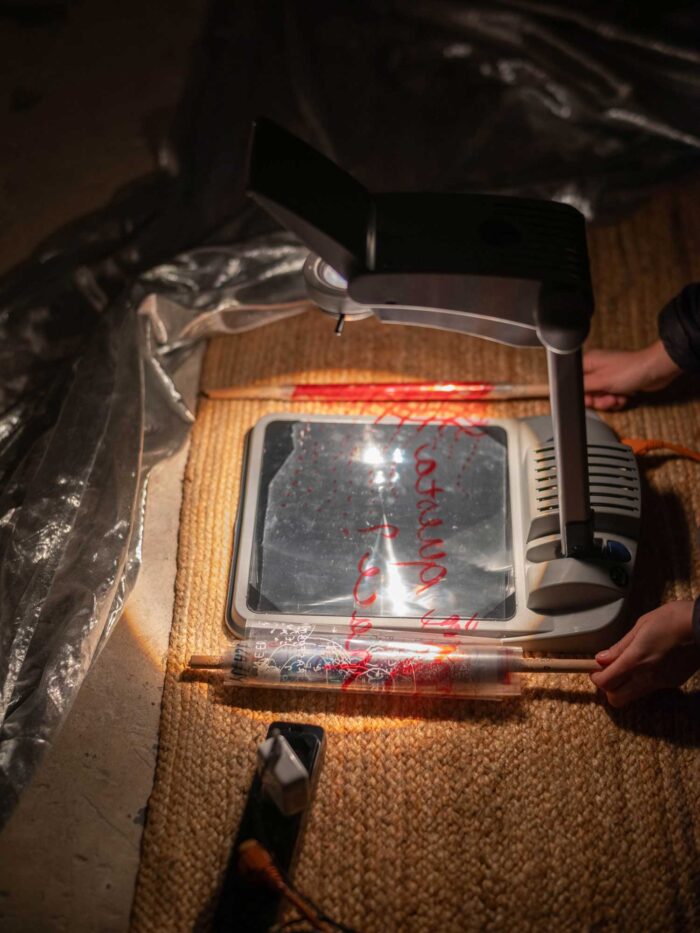
To conclude, I always like to ask this question: are there techniques, mediums, or ideas you haven’t explored yet but would like to experiment with? What future developments do you envision for your artistic practice?
I recently found, at the Bishopsgate Institute in London, a series of small drawings of women in the 19th century who built large backpacks for carrying magic lanterns. They would transport them to fairs and villages, sharing the magic of the first moving images. I’d like to create a project celebrating these wandering, magical figures. Currently, I’m dreaming and working simultaneously on this idea.


